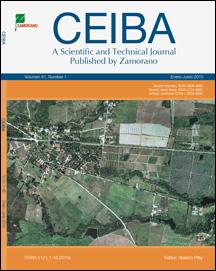Selection Criteria and Performance of Energycane Clones (Saccharum spp. × S. spontaneum) for Biomass Production Under Tropical and Sub-tropical Conditions
DOI:
https://doi.org/10.5377/ceiba.v51i1.641Palabras clave:
Biomass, biofuel, invasiveness, feedstockResumen
The urgent need to reduce our reliance on oil and at the same time reduce carbon emissions, has triggered the search for alternative energy sources such as biofuels. New technologies have made possible the conversion of cellulose and hemicellulose into sugars that can be fermented to produce ethanol. This opened the possibility that any plant species can be used for ethanol production. Species that produce large amounts of biomass in a short time are desirable. For this reason, one of the most critical steps in the development of biofuel production is to identify appropriate species that will provide the necessary biomass for cellulosic ethanol or direct combustion. Energycanes are wide crosses of commercial sugarcane (a complex hybrid of Saccharum spp.) with S. spontaneum clones which produce high-biomass plants with high fiber content and good cold and disease tolerance as well as excellent ratooning ability. A large scale study has been established to evaluate biomass production, growth characteristics and invasive potential of energycane clones under tropical (Limón, Costa Rica) and subtropical (South Florida) conditions since 2008. In Florida in a low fertility sandy soil, energycane clones and the grass species Pennisetum purpureum var. Merkeron showed the highest yields ranging from 50 to 78 ton ha-1 of fresh weight. These clones were not susceptible to smut (Sporisorium scitaminea) unlike the energycane L79-1002 which is currently the most widely grown clone of energycane. Most clones showed lateral vegetative growth, but no pollen or seed viability. In Costa Rica, the evaluation of 15 energycane clones is still in progress, however preliminary results indicated that the energycane clones had faster and more vigorous growth than the commercial sugarcane varieties, only exceeded by P. purpureum. In comparison with commercial sugarcane varieties, the energycane clones recorded 37% higher leaf area index (LAI) and height, and 65% more stalks per unit area. No evident disease susceptibility was observed in the energycane clones in the tropics, although lateral vegetative growth was observed in all clones. Additionally, all clones flowered and produced viable pollen which suggests that these clones have a higher invasive potential in the tropics. The information available until now suggests that the behavior of energycane germplasm varies importantly between tropical and sub-tropical conditions. Therefore, selection and breeding programs must be carefully developed accounting for the unique responses that this germplasm could show under these two different climatic conditions.
Descargas
929




